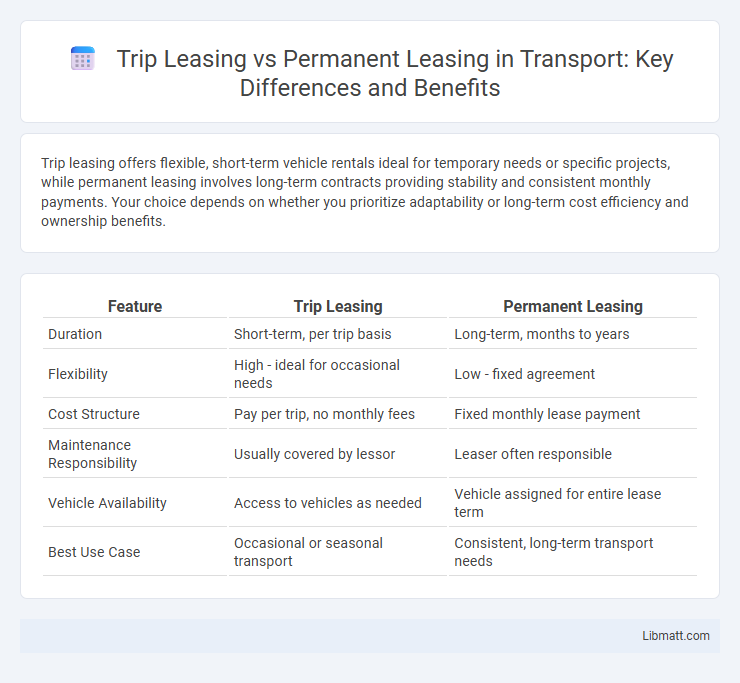Trip leasing offers flexible, short-term vehicle rentals ideal for temporary needs or specific projects, while permanent leasing involves long-term contracts providing stability and consistent monthly payments. Your choice depends on whether you prioritize adaptability or long-term cost efficiency and ownership benefits.
Table of Comparison
| Feature | Trip Leasing | Permanent Leasing |
|---|---|---|
| Duration | Short-term, per trip basis | Long-term, months to years |
| Flexibility | High - ideal for occasional needs | Low - fixed agreement |
| Cost Structure | Pay per trip, no monthly fees | Fixed monthly lease payment |
| Maintenance Responsibility | Usually covered by lessor | Leaser often responsible |
| Vehicle Availability | Access to vehicles as needed | Vehicle assigned for entire lease term |
| Best Use Case | Occasional or seasonal transport | Consistent, long-term transport needs |
Understanding Trip Leasing and Permanent Leasing
Trip leasing involves short-term vehicle rentals typically used to cover temporary demand spikes or vehicle shortages without long-term commitment, providing flexibility to fleet operators. Permanent leasing entails a longer-term contract where a vehicle is leased for an extended period, often with fixed monthly payments and full maintenance obligations, which suits consistent operational needs. Understanding these distinctions helps businesses optimize fleet management strategies based on cost-efficiency, usage duration, and maintenance responsibility.
Key Differences Between Trip Leasing and Permanent Leasing
Trip leasing offers short-term vehicle access, ideal for temporary needs, while permanent leasing involves long-term contracts with fixed monthly payments. Trip leasing provides flexibility and lower commitment, whereas permanent leasing often includes maintenance and insurance services as part of the deal. The primary difference lies in duration, cost structure, and associated service packages, impacting overall financial planning for individuals or businesses.
How Trip Leasing Works
Trip leasing allows companies to rent equipment or vehicles for short-term use, typically ranging from a few days to several months, providing flexibility without long-term commitments. This model enables businesses to scale operations quickly and manage seasonal demand without investing in permanent assets. Contracts in trip leasing often include maintenance and support services, ensuring operational efficiency during the lease period.
How Permanent Leasing Works
Permanent leasing involves signing a long-term rental agreement, typically spanning six months to several years, where you occupy the property as your primary residence. The lease contract outlines fixed monthly payments, maintenance responsibilities, and terms for renewal or termination, providing stability and predictable housing costs. You gain the security of a consistent living arrangement without the flexibility limits found in short-term or trip leasing options.
Pros and Cons of Trip Leasing
Trip leasing offers flexibility by allowing businesses to lease vehicles for short-term use, reducing commitment and upfront costs compared to permanent leasing. It enables quick adaptation to fluctuating fleet demands but often comes with higher per-day rates and limited vehicle customization options. While cost-effective for temporary needs, trip leasing may result in less predictable expenses and potential availability issues during peak periods.
Pros and Cons of Permanent Leasing
Permanent leasing offers stability with fixed monthly payments and long-term vehicle use, making it ideal for individuals seeking consistent transportation without ownership responsibilities. However, it often includes higher total costs due to long-term contracts and potential penalties for early termination. Depreciation risks remain with permanent leasing, as lessees may be liable for vehicle wear and tear beyond normal use.
Choosing the Right Option: Factors to Consider
Trip leasing offers flexibility with short-term commitments, ideal for businesses experiencing fluctuating demand or project-based needs. Permanent leasing provides stability and long-term cost savings, suitable for companies with consistent fleet requirements and predictable usage patterns. Evaluating factors such as budget constraints, operational duration, maintenance responsibilities, and scalability ensures the optimal leasing strategy aligned with business goals.
Cost Comparison: Trip Leasing vs Permanent Leasing
Trip leasing typically incurs higher per-day costs due to its short-term nature and flexibility, whereas permanent leasing offers lower monthly rates because of long-term commitments and stable usage. Your overall expenses in trip leasing may increase with frequent renewals and variable demand, while permanent leasing benefits from fixed payments and potential discounts. Evaluating your usage patterns and budget needs will determine whether trip leasing's adaptability or permanent leasing's cost-efficiency suits your financial goals.
Legal and Regulatory Considerations
Trip leasing involves short-term contracts subject to specific transport and labor regulations that vary by jurisdiction, often requiring separate permits or licenses for each trip. Permanent leasing arrangements are governed by long-term rental agreements that must comply with comprehensive vehicle registration, insurance mandates, and local leasing laws. Understanding the distinct legal frameworks for your trip or permanent leasing ensures compliance and minimizes risk.
Frequently Asked Questions on Truck Leasing Options
Trip leasing offers short-term, flexible truck rental solutions ideal for seasonal or project-based needs, while permanent leasing involves long-term commitments with potential benefits like lower monthly costs and maintenance coverage. Your choice depends on factors such as budget, duration, and operational demands, with trip leases providing quick access without long-term obligations. Frequently asked questions often address contract length, mileage limits, maintenance responsibilities, and cost comparison between these leasing options.
trip leasing vs permanent leasing Infographic

 libmatt.com
libmatt.com